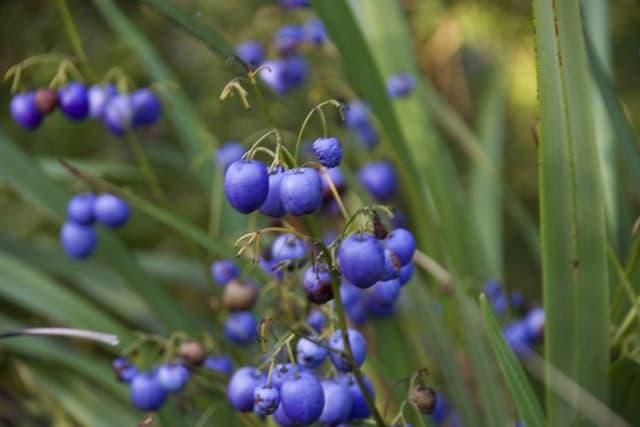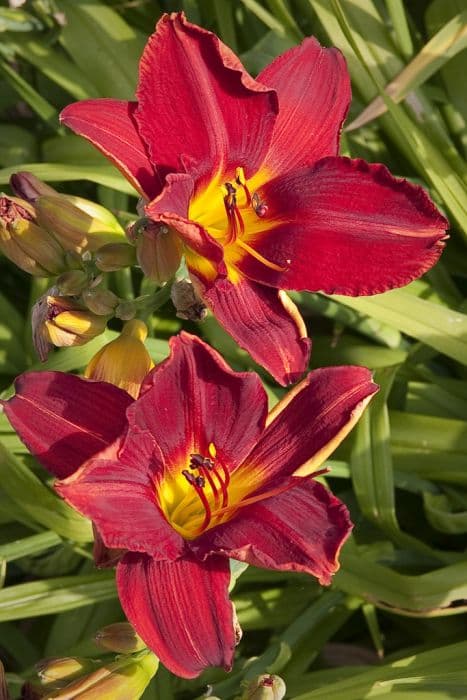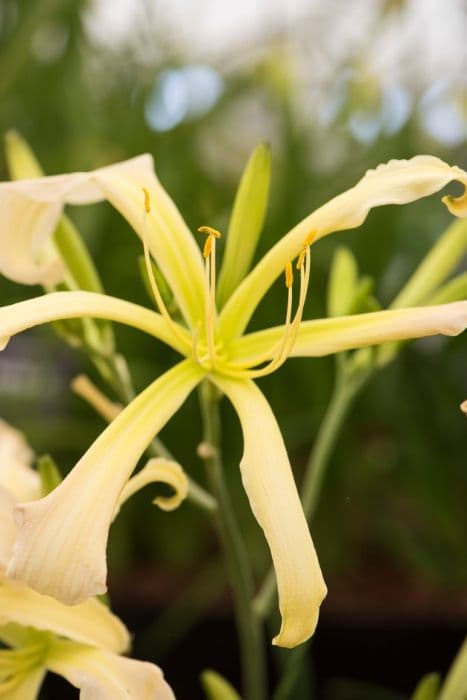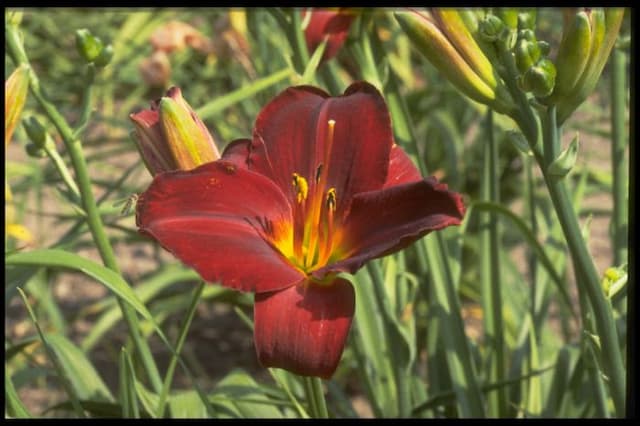Daylily Hemerocallis 'Beloved Returns'

ABOUT
The Hemerocallis 'Beloved Returns', more commonly known as the Daylily 'Beloved Returns', is a delightful perennial that is cherished for its captivating blooms. This plant features an abundance of flowers that exhibit a soft, pastel color palette, often with petals that are a delicate blend of creamy yellows and light pinks, graced with a subtle eye that can display deeper shades and a distinguishing throat that often highlights a striking, vibrant contrast. The flowers of the Daylily 'Beloved Returns' are trumpet-shaped, boasting a symmetrical form that unfurls from a narrow base into a broad, flared opening. The petals themselves can be lightly ruffled along the edges, adding a touch of elegance to the flower's overall form. Each flower is typically borne on strong, erect stems that rise well above the foliage, presenting the blooms prominently when they are in full display. Supporting the showy flowers is a tidy clump of slender, arching foliage. The leaves are long and blade-like, with a rich green color that provides an excellent backdrop to the floral exhibition. The foliage has a grass-like appearance and forms a fountain-like mound, which complements the garden with both texture and lushness. While the Daylily 'Beloved Returns' is in bloom, it creates an eye-catching spectacle that is sure to attract attention and add a sense of charm to any garden setting.
About this plant
 Names
NamesSynonyms
Daylily, Common Daylily, Day Lily
Common names
Hemerocallis 'Beloved Returns'
 Toxicity
ToxicityTo humans
The plant commonly known as Daylily is generally considered non-toxic to humans when consumed in moderation. Many parts of the Daylily, such as the flowers and tubers, are even edible and have been used in culinary applications in certain cultures. However, it's essential to note that not every person might react the same way to ingesting parts of this plant. Sensitive individuals could potentially experience mild stomach upset. It is always advisable to exercise caution and verify the edibility of specific cultivars before consumption.
To pets
Daylilies are toxic to cats and can cause severe kidney damage. If a cat ingests any part of a Daylily, the symptoms of poisoning can appear within hours and may include vomiting, lethargy, kidney failure, or even death if not treated promptly. Dogs are not considered as sensitive to Daylilies as cats, but it is still a good practice to prevent dogs from ingesting this plant to avoid the possibility of gastrointestinal upset or other health issues. Pet owners should monitor their animals closely and consult a veterinarian if any signs of Daylily ingestion are noticed.
 Characteristics
CharacteristicsLife cycle
Perennials
Foliage type
Deciduous
Color of leaves
Green
Flower color
Pink
Height
1-2 feet (30-60 cm)
Spread
1-2 feet (30-60 cm)
Plant type
Herb
Hardiness zones
3-9
Native area
Asia
Benefits
 General Benefits
General Benefits- Easy to Grow: Thrives in a variety of soil types and environmental conditions.
- Long Blooming: Provides a prolonged display of large, colorful flowers each season.
- Drought Tolerant: Once established, can survive with minimal watering.
- Attracts Pollinators: Flowers are a nectar source for bees and butterflies.
- Low Maintenance: Requires minimal care once planted, making it ideal for busy gardeners.
- Multiplication: Propagates by division, allowing gardeners to increase their stock over time.
- Landscape Versatility: Suitable for borders, flower beds, and large plantings.
- Color Variety: Offers a wide range of flower colors for enhancing garden aesthetics.
 Medical Properties
Medical PropertiesThis plant is not used for medical purposes.
 Air-purifying Qualities
Air-purifying QualitiesThis plant is not specifically known for air purifying qualities.
 Other Uses
Other Uses- Many daylily enthusiasts use Hemerocallis 'Beloved Returns' for hybridizing purposes, attempting to produce new cultivars with unique colors and patterns by cross-pollinating the flowers.
- The sturdy, fibrous roots of the daylily can be utilized in controlling erosion on slopes and banks by stabilizing the soil.
- Daylily buds and flowers are edible and can be used in salads, soups, or as a garnish, providing a mild, sweet flavor and a crunchy texture.
- The foliage of daylilies, when planted in mass, can provide a lush ground cover, suppressing weeds and reducing garden maintenance tasks.
- Due to their extensive root system, daylilies can be planted alongside bodies of water to help filter runoff and improve water quality.
- Daylilies can be used as a natural dye source, where different parts of the plants create varying shades of yellow and orange dyes for fabrics.
- The flowers of the daylily can be crystallized with sugar and used as an elegant and edible decoration on cakes and desserts.
- Daylily clumps can serve as a protective shelter for small garden wildlife such as frogs, toads, and beneficial insects.
- With their dense roots and foliage, daylilies can be strategically planted to provide privacy and as a windbreak in residential landscapes.
- The spent blooms and dead foliage of daylilies serve as organic matter, contributing to compost and improving soil structure over time when decomposed.
Interesting Facts
 Feng Shui
Feng ShuiThe Daylily is not used in Feng Shui practice.
 Zodiac Sign Compitability
Zodiac Sign CompitabilityThe Daylily is not used in astrology practice.
 Plant Symbolism
Plant Symbolism- Perseverance: Daylilies, including Hemerocallis 'Beloved Returns', typically symbolize perseverance due to their hardiness and ability to thrive in a variety of conditions.
- Motherhood: The daylily's numerous offspring or blooms, which can emerge from a single plant, are often seen as a representation of motherhood and fertility.
- Renewal: As the name "daylily" suggests (hemero means day and kallos means beauty in Greek), each flower typically lasts just one day, which symbolizes the idea of renewal and the fleeting nature of life.
- Longevity: Despite the individual flowers' short lifespan, daylilies can live for a long time, returning year after year, which can symbolize hope for a long life.
- Forgotten or Lost Love: Sometimes, due to the ephemeral nature of the flowers, daylilies can represent love that is lost or affection that has faded with time.
 Water
WaterDaylilies, like the Hemerocallis 'Beloved Returns', prefer to be watered deeply about once a week, receiving approximately 1 inch of water each time. It's crucial to allow the soil to dry out somewhat between waterings to prevent root rot. In hotter, drier climates, or during particularly hot spells, you may need to water twice a week. Adjust your watering schedule if natural rainfall provides an equivalent amount. To avoid water waste and minimize leaf wetness, which can lead to disease, it is recommended to use soaker hoses or drip irrigation at the base of the plants, providing about 1-1.5 gallons per plant per week.
 Light
LightDaylilies, including the Hemerocallis 'Beloved Returns', thrive in full sun, so a location receiving at least 6 hours of direct sunlight per day is ideal. However, they can tolerate partial shade, especially in very hot climates where some afternoon shade can be beneficial. Avoid heavily shaded areas where they may struggle to bloom and become more susceptible to fungal diseases.
 Temperature
TemperatureThe daylily, Hemerocallis 'Beloved Returns', is a resilient plant that can survive in a wide range of temperatures but prefers a temperate climate. They can tolerate temperatures down to about 20°F but perform best when the daytime temperatures range from 60°F to 90°F. It’s during this temperature range that they will exhibit the most vigorous growth and optimal blooming.
 Pruning
PruningFor daylilies like Hemerocallis 'Beloved Returns', pruning, which is usually the removal of spent flowers and seed pods, encourages reblooming and tidies the plant's appearance. Cut back the foliage in late fall or early spring to remove any dead leaves and to help prevent disease. Regular deadheading of the spent flowers during the blooming season can also promote further blooms.
 Cleaning
CleaningAs needed
 Soil
SoilDaylilies thrive in well-draining soil with a pH between 6.0 and 6.5. A good soil mix for Daylilies is one part loam, one part peat moss, and one part perlite or sand to ensure proper drainage. Adding compost or well-rotted manure provides nutrients and improves soil structure.
 Repotting
RepottingDaylilies, also known as Hemerocallis, generally do not require frequent repotting as they are perennial plants grown outdoors. They can be divided every 3 to 5 years to maintain vigor and to propagate them.
 Humidity & Misting
Humidity & MistingDaylilies (Hemerocallis) are tolerant of a wide range of humidity levels as outdoor plants. A standard garden atmosphere with no specific humidity modification is sufficient for their growth.
 Suitable locations
Suitable locationsIndoor
Allow bright light, avoid water logging, repot as necessary.
Outdoor
Plant in full sun to part shade, ensure well-drained soil.
Hardiness zone
3-9 USDA.
 Life cycle
Life cycleThe common name for Hemerocallis 'Beloved Returns' is Daylily. The life cycle begins with seed germination, where the plant emerges as a small seedling and starts to develop roots and foliage. Following germination, the daylily enters a vegetative phase, characterized by the growth of long, strap-like leaves and the establishment of a strong root system. As the plant matures, it enters the flowering phase, during which numerous buds form on tall flower stalks called scapes and bloom into vibrant, trumpet-shaped flowers that typically last just one day each. After pollination, if it occurs, seed pods may form and, once matured, release seeds to start the next generation. During the dormant phase, which occurs in cold climates during winter, the daylily's foliage dies back, and the plant rests until the favorable growth conditions of spring return.
 Propogation
PropogationPropogation time
Late summer
Propogation: The most popular method for propagating the Daylily 'Beloved Returns' is by division. This is ideally done in early spring or late summer to early fall. To propagate by division, a gardener would carefully dig up the clump of daylilies, making sure to lift the entire root system. Then they would gently separate the clump into smaller sections, ensuring that each section has at least one fan of leaves and a portion of the root system. These divided sections are then replanted at the same soil depth they were growing previously, spaced about 12 to 18 inches (approximately 30 to 46 centimeters) apart to allow for growth. Watering thoroughly after replanting is essential to help establish the new divisions.









